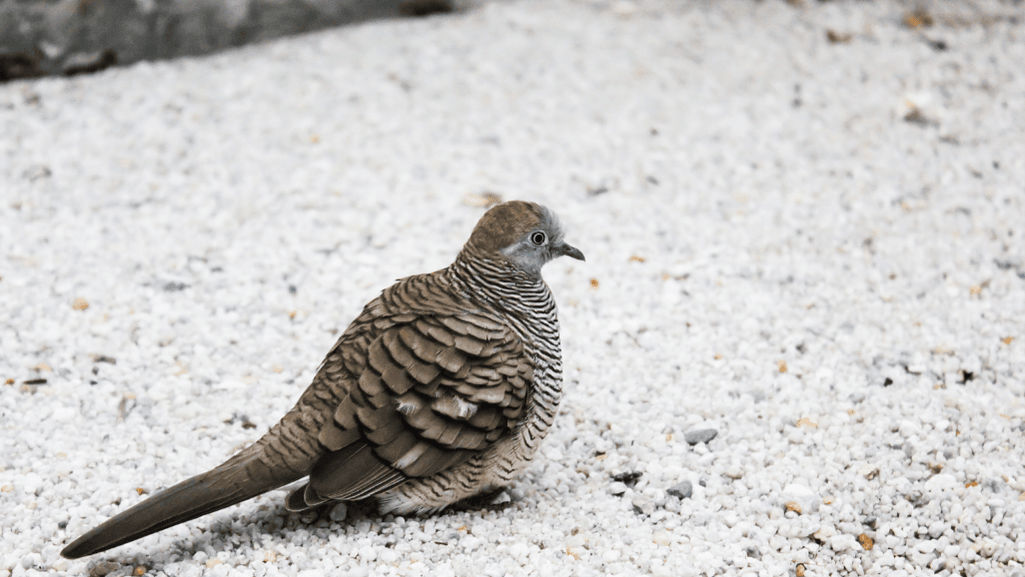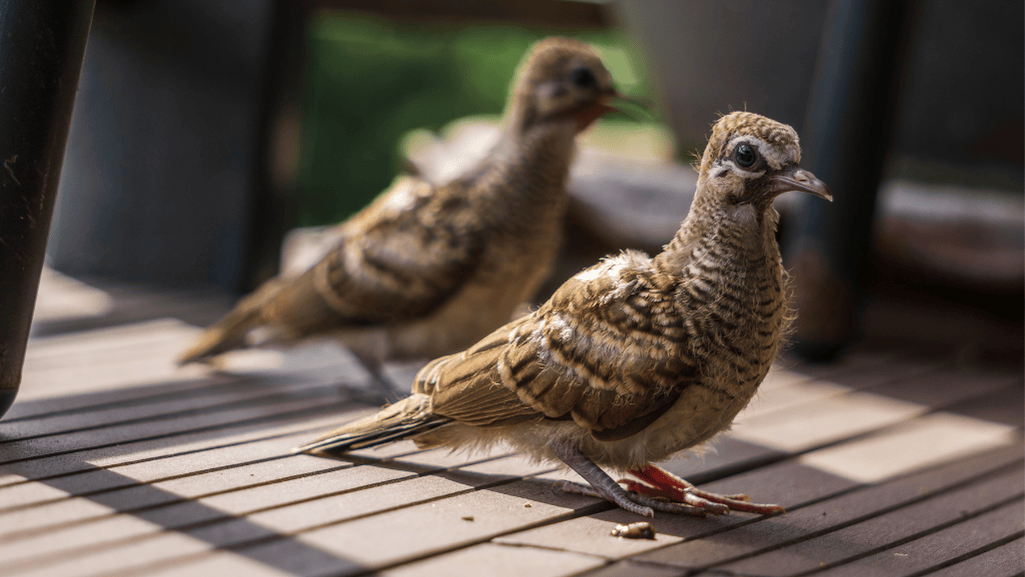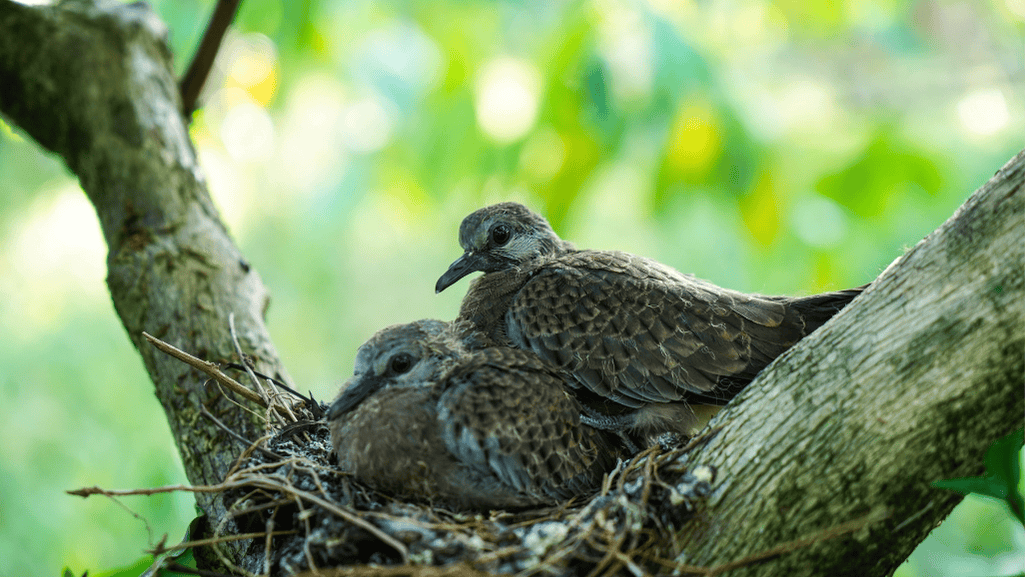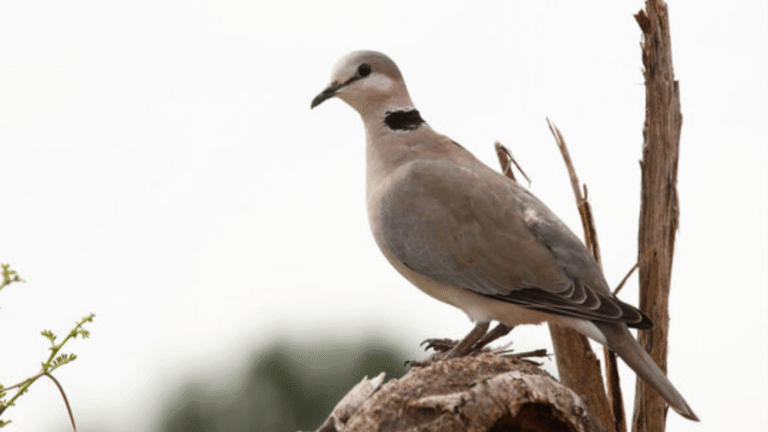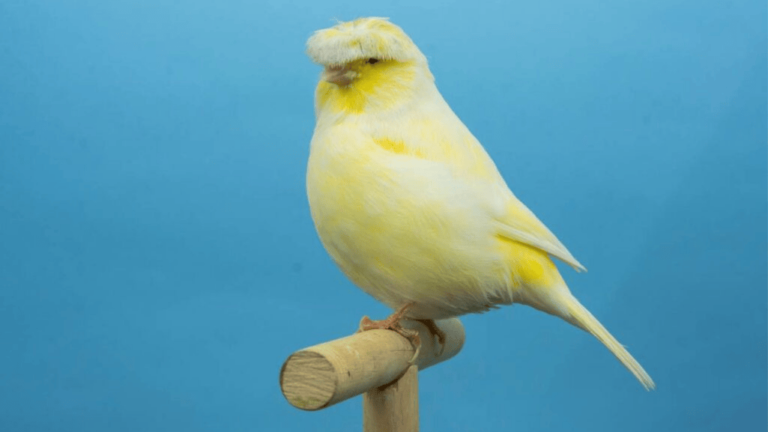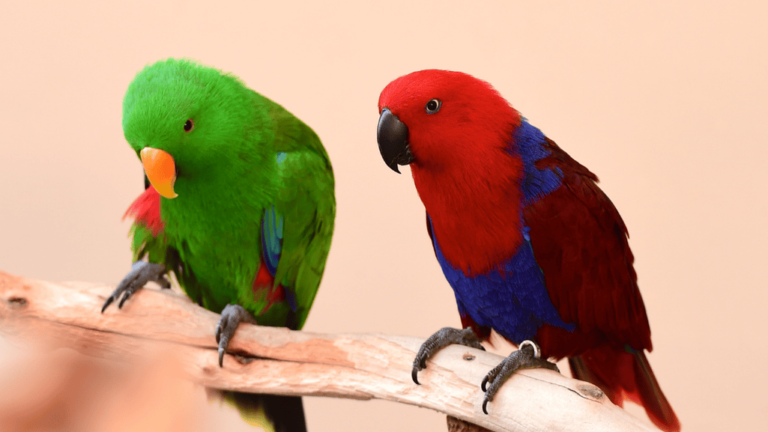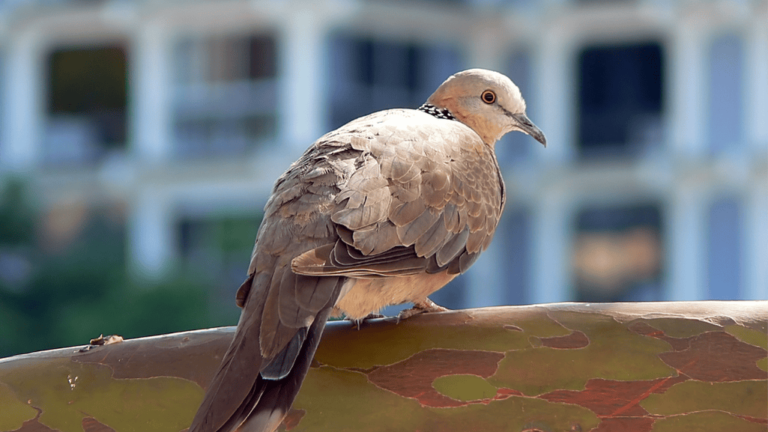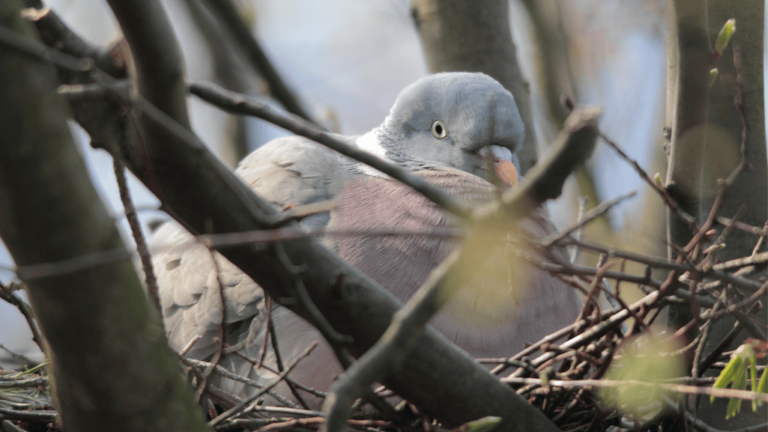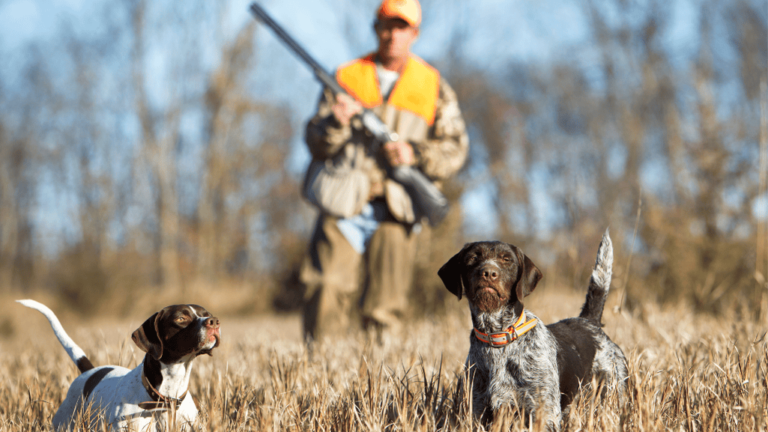Mourning doves are known for their beautiful songs and symbol of peace. They are interesting to watch, especially with their young. These young doves, also called baby doves or dove chicks, grow fast from the moment they are born. Learning about their behavior and growth helps us appreciate these birds more.
Mourning dove pairs often have multiple broods a year, with two eggs in each clutch. After 14 days, the eggs hatch, showing tiny, helpless dove babies. These young doves grow fast, getting feathers and weight quickly.
In just two weeks, they change from naked nestlings to fully feathered fledglings, ready to explore the world. After that, these young birds still need their parents for food and advice. The parents work hard to help their babies survive, with the male feeding them more as they get older.
This shows us the amazing journey these birds go through from eggs to grown birds. It helps us understand and appreciate mourning doves more.
Key Takeaways
- Mourning doves raise multiple broods per year, with each clutch usually consisting of two eggs.
- Dove chicks grow rapidly, developing from naked nestlings to fully feathered fledglings within two weeks.
- Both parents care for the young, with the male taking on a more significant role in feeding as the fledglings grow older.
- Understanding the behavior and development of dove fledglings can deepen our appreciation for these fascinating birds.
- Observing the various stages of growth and parenting behaviors provides insight into the life cycle of mourning doves.
Identifying Mourning Dove Eggs
Mourning dove eggs are a key part of these birds’ life cycle. Knowing how to spot and understand dove eggs helps us appreciate these gentle birds more. It’s important to know about dove egg appearance and dove clutch size when studying their nests.
Appearance of Mourning Dove Eggs
Mourning dove eggs are small and have a smooth, slightly shiny surface. They are white dove eggs that look plain or simple. It’s hard to tell them apart from other dove species just by looking at them.
Mourning dove eggs are known for their pure white color and simple, understated beauty.
Even though they look simple, these nondescript dove eggs are vital for the species’ survival. Both parents take turns to keep the eggs warm and safe until they hatch.
Number of Eggs per Clutch
Mourning doves usually lay two eggs per nest. This is a common number for them. The female lays the first egg soon after finishing the nest, and then the second egg a day or two later.
- Mourning doves lay two plain, white eggs per clutch
- Each clutch of eggs usually produces two baby mourning doves
- Mourning dove pairs may have up to five or six broods in a single season
The small size of mourning dove eggs and the consistent dove clutch size fit well with their fast breeding cycle. They can have many broods in a season, which helps their population stay stable and strong.
Mourning Dove Egg Incubation Period
Mourning dove incubation lasts about 14 days, a key part of their nesting cycle. Both parents take turns to keep the eggs warm and help them develop. They aim for a temperature of 99°F to 100°F and keep the humidity right to avoid egg weight loss.
During this time, the parents work together to protect and warm the eggs. They switch duties so one can feed or rest while the other stays with the eggs. This teamwork is crucial since many mourning doves don’t make it to adulthood or their first year.
These birds are known for their high breeding rate, making 2 to 5 nests a year. The female lays two eggs, which are kept warm for about two weeks. Some breeders suggest using a red light bulb to help the eggs hatch better.
| Incubation Period | Temperature | Humidity | Egg Weight Loss |
|---|---|---|---|
| 14 days | 99°F – 100°F | Carefully monitored | Should not exceed 12% |
Mourning doves are under the Migratory Bird Treaty Act, making it illegal to keep them as pets in many places without a permit. If you find a baby dove without parents, call a licensed wildlife rehabber or a wildlife refuge for help.
Mourning doves are managed as a game species in about 37 states, with hunting seasons set to keep their numbers healthy.
Even though they don’t live long, mourning doves are important to the ecosystem. They eat mostly weed seeds and waste grain, which helps control weeds in farms.
Characteristics of Baby Mourning Doves
Baby mourning doves, also known as squabs or nestlings, are born helpless. They rely entirely on their parents for survival. These tiny hatchlings come out of their eggs with closed eyes and a delicate, downy look. As they grow, they change a lot, slowly getting the looks of adult mourning doves.
Appearance of Newly Hatched Doves
When they hatch, baby mourning doves are covered in soft, ivory-colored down. This fluffy down keeps them warm and safe. Their eyes stay closed for a few days, and they are very small and fragile. At this point, they depend on their parents for everything.
Newly hatched mourning doves weigh a mere 6-8 grams and measure approximately 5 cm in length.
Development of Feathers
As the baby mourning dove grows, it starts to get its first real feathers, called pin feathers. These feathers come out as small, dark shafts and then open up to show the downy feathers of young doves. In two weeks, the dove changes a lot:
- Pin feathers grow and spread over the wings, tail, and body
- The soft down is replaced by a mix of downy and adult feathers
- The dove gets bigger, its weight increases a lot
- Eyes open, and the dove becomes more aware of its surroundings
| Age (Days) | Developmental Milestone |
|---|---|
| 0-3 | Hatchling covered in natal down, eyes closed |
| 4-7 | Eyes open, pin feathers begin to emerge |
| 8-14 | Feathers continue to grow, body size increases rapidly |
| 15-21 | Fully feathered, ready to leave the nest (fledge) |
By the end of the second week, the helpless hatchling dove has turned into a fully feathered young dove. It looks a lot like its parents. This quick growth is key for the dove’s survival. It needs to be ready to leave the nest and face the world outside.
Feeding Baby Mourning Doves
Feeding baby mourning doves the right food is key to their growth and health. These young birds need certain foods to survive and grow well. Both parents work together to feed their babies.
Crop Milk: Essential Nutrition for Young Doves
Baby mourning doves eat a special food called crop milk when they are very young. Adult doves make this food in their throats. It has a lot of water, protein, and fat, but not much carbs.
- 70% water
- 53-58% protein
- 34-35% fat
- Minimal carbohydrates
This diet helps the baby doves grow fast. Parents feed their babies by giving them crop milk in their mouths. This keeps the babies well-fed.
Transition to a Seed-Based Diet
As baby doves get bigger, they need different food. Around 2 weeks old, they start eating solid food. They move from eating crop milk to eating seeds, which is what adult doves eat.
During this change, parents still give crop milk but also teach their babies to find seeds. By 4 weeks, the babies can eat seeds on their own.
| Age (in weeks) | Primary Food Source |
|---|---|
| 0-2 | Crop milk |
| 2-4 | Gradual transition to seeds |
| 4+ | Primarily seeds |
Knowing what baby mourning doves need to eat is important for their care. Whether they are in the wild or with people, giving them the right food at each stage is key. This helps them stay healthy and well.
Fledgling Stage: When Baby Doves Leave the Nest
Baby doves grow up and hit a big milestone called the dove fledgling stage. At this point, they are 12 to 21 days old, depending on the type of dove. They are big enough to leave the nest and see the world. But, they still have a lot to learn before they can be on their own.
Age at Fledging
The dove fledging age changes with different dove types. Usually, baby doves are ready to leave the nest at about two to three weeks old. They have enough feathers and strength for short flights and can perch on branches. But, they’re not very good at flying yet and might seem clumsy as they learn.
| Species | Average Fledging Age (Days) |
|---|---|
| Mourning Dove | 12-15 |
| White-winged Dove | 14-18 |
| Eurasian Collared-Dove | 15-19 |
| Rock Pigeon | 18-21 |
Continued Parental Care after Fledging
When baby doves leave the nest, it’s a big step towards being independent. But, it doesn’t mean the parents stop caring for them. Dove parents keep helping their young for weeks after they leave the nest. This parental care for fledglings is key for their survival and growing up.
Parents watch over their young, keeping them safe from dangers and feeding them when they need it. Fledglings might come back to the nest or nearby to rest and eat. Over time, they get better at flying and start to explore more, eventually finding their own food.
Helping dove families during the fledgling stage is very important. By giving them safe places to nest and different foods, like the Lyric Fine Tunes No Waste Mix, we support these young birds as they learn about the world.
As fledglings become more independent, they spend less time with their parents and more time on their own. Learning and exploring is key for their survival. They need to know how to find food, avoid predators, and make their own territories and families. By understanding their challenges and helping them, we can support these amazing birds for years to come.
Identifying Juvenile Mourning Doves
Young mourning doves change a lot as they grow. Spotting a juvenile mourning dove is fun for bird lovers. They look a lot like adults but have some key differences.
A juvenile mourning dove has white marks on its face and white spots on feathers. These signs show it’s a young dove. These marks fade as the dove gets older. It will grow into the gray-brown color of an adult dove.
Observing the subtle changes in dove plumage development can be a rewarding experience for bird watchers and nature enthusiasts.
To spot a juvenile mourning dove, look for these things:
- White marks on the face and white spots on feathers
- Compare its color to an adult dove’s
- Watch how it acts with other doves
Young mourning doves act differently from adults. They often stay on the ground learning to find food and move around. They also make special sounds to talk to their family.
| Age | Plumage Characteristics |
|---|---|
| Newly Hatched | Covered in sparse, yellow down feathers |
| 1-2 Weeks | Development of adult feather sheaths, darker and more speckled than adult plumage |
| 2-4 Weeks | White markings on face and white spots at feather tips, gradual fading as the bird matures |
As they grow, juvenile mourning doves learn to survive on their own. Knowing how they look and act helps us see their amazing growth from young to adult birds.
Caring for Abandoned or Orphaned Baby Doves
Finding an abandoned baby dove can be very sad for bird lovers. Before you try to rescue a baby dove, make sure it really needs help. Sometimes, people help when the baby dove is actually being taken care of by its parents.
Determining if a Baby Dove Needs Assistance
When you see a baby mourning dove on the ground, look closely at its condition and where it is. If it’s a nestling without feathers, put it back in its nest if you can. If you can’t find the nest or get to it, call a licensed wildlife rehabilitator. They know how to take care of orphaned dove care.
Fledglings, with most feathers, are learning to fly and explore. Their parents are usually nearby, watching over them and feeding them. Unless it looks hurt, sick, or in danger, don’t move it. Let the parents take care of it.
Proper Steps to Take for Nestlings and Fledglings
If a baby dove really needs help, here’s what to do:
- Put nestlings back in their nest if you can. If not, call a wildlife rehabilitator for advice on making a nest or getting professional help.
- Check if a fledgling is okay. If it seems healthy and not hurt, let it stay where it is. The parents will keep feeding and caring for it.
- If a fledgling is in danger, like from predators or people, move it to a safe spot. Put it in a bush or a low tree branch. This lets the parents find and care for their baby.
- If a baby dove is hurt, sick, or its parents are dead, call a wildlife rehabilitator or a vet who knows about birds. They can help with treatment and care.
When taking care of an orphaned baby dove, keep it at the right temperature and feed it right. Keep it at about 95°F (35°C), then lower the temperature by one degree each day. Use a special baby bird formula, like Kaytee Exact Hand Feeding Formula, to feed it. Baby doves eat differently than other baby birds, sucking the food into their beaks instead of opening their mouths.
| Age of Baby Dove | Feeding Frequency | Temperature |
|---|---|---|
| First week | 4-5 times daily | 95°F (35°C) |
| Second week | 3-4 times daily | 90°F (32.2°C) |
| Third week | 2-3 times daily | 85°F (29.4°C) |
| Fourth week | 2 times daily | Room temperature |
Remember, only rescue dove nestlings and fledglings when really needed. Often, letting the parents take care of their babies is the best option.
If you need to help an abandoned baby dove, get advice from wildlife rehabilitators or bird vets. They have the skills and care to help the dove survive and be released back into the wild.
Dove Fledgling Development Milestones
Dove fledgling growth is a fascinating process with key milestones. From the moment they hatch, baby doves start a journey of rapid development. It’s important to know these stages for those who care for these delicate creatures.
The first few days of a dove’s life are the hatchling stage, from 0 to 3 days old. During this time, the tiny birds have downy feathers and rely on their parents for everything. As they move to the nestling stage, from 3 to 13 days old, they grow a lot and start to get their body feathers.
At around 13 to 14 days old, young doves enter the fledgling stage. This is a critical point in their growth. They are fully feathered and ready to leave the nest, but they still need some help from their parents. Fledglings spend a few days exploring and practicing their flying skills before they become independent. For more info on baby dove development, check out East Valley Wildlife.
| Development Stage | Age Range | Key Characteristics |
|---|---|---|
| Hatchling | 0-3 days old | Covered in downy feathers, entirely dependent on parents |
| Nestling | 3-13 days old | Significant growth, body feathers begin to develop |
| Fledgling | 13-14 days old or older | Fully feathered, ready to leave the nest, still requires some parental care |
During the nesting period, parent doves work hard to ensure their babies survive and thrive. They take turns incubating eggs, feeding the young, and protecting them from dangers. Before fledging, parents feed their young many times a day, with each feeding lasting 30 seconds to 1 minute.
As the nestlings prepare to leave the nest, they may show restless behavior for 1 to 3 days. Parents call from around to encourage fledging.
Once a fledgling flies for the first time, it stays perched for half an hour to three hours before flying to a nearby tree. Understanding these milestones and the hard work of their parents helps us appreciate the dove’s remarkable growth and development.
Mourning Dove Parenting Behaviors
Mourning doves are dedicated parents, working together to ensure their young survive and thrive. They usually raise one or two babies at a time. But, they can have three or more babies in the spring and summer. A pair of doves can have multiple broods of one or two youngsters in a season.
They have a quick turnaround in nesting. A new group of babies can hatch in less than two weeks after the last ones leave the nest.
Shared Incubation Duties
Both male and female mourning dove adults take turns sitting on the eggs for about 14 days. This shared responsibility keeps the eggs warm and safe. It’s a key part of dove incubation behavior.
Feeding and Caring for Fledglings
After the eggs hatch, the parents keep feeding the babies with crop milk. As the young grow, they start to eat regurgitated seeds. Even after the young birds leave the nest, the parents help them for another week or two.
They teach them how to find food and avoid predators.
| Parenting Behavior | Description |
|---|---|
| Incubation | Both parents take turns incubating the eggs for about 14 days |
| Feeding Nestlings | Parents feed nestlings crop milk and gradually transition to regurgitated seeds |
| Post-Fledging Care | Parents continue to feed and care for fledglings for 1-2 weeks after leaving the nest |
The commitment of mourning dove parents is crucial for their babies’ survival and growth. Their shared duties and careful attention show the amazing parenting of these gentle birds. This ensures their species thrives despite many challenges.
Challenges Faced by Dove Fledglings in Urban Environments
Dove fledglings in cities face many challenges as they move through the busy city. A study by Oklahoma State University Extension found that mourning doves like open or semi-open lands for food and rest. But, cities bring special problems for these young birds.
High temperatures, between 35°C and 39°C, are a big issue for young doves. These heat levels make it hard for them to keep their body temperature right and can cause dehydration. The city’s heat islands, from lots of concrete and little green space, make this worse for doves.
Finding enough food is another big challenge for doves in the city. Adult doves eat seeds and fruits, but finding these in the city is hard. Young doves depend on their parents to show them where to find food. But, with less green space and natural plants in cities, this is harder.
Caring for a baby dove in the city means paying close attention to its diet. Without special formulas, you might use boiled and mashed green mung beans, oatmeal, or certain types of bread.
Young doves also risk hitting buildings or windows as they learn to fly. They might not know how to avoid these dangers, which could hurt them or be fatal.
Predators like cats and hawks are a big threat in cities too. Young doves are easy targets as they learn to fly and find their own food. Without much natural cover, they’re more likely to be caught by predators.
| Challenge | Description | Impact on Fledglings |
|---|---|---|
| High temperatures | City temperatures ranging from 35°C to 39°C | Difficulty maintaining body temperature and risk of dehydration |
| Limited food sources | Scarcity of natural seeds, fruits, and berries in urban areas | Challenges in finding appropriate nutrition for growth and development |
| Collision with man-made structures | Buildings, windows, and other urban obstacles | Risk of injury or death due to collisions while learning to fly |
| Predator presence | Cats, hawks, and other predators in the city | Increased vulnerability to predation during the fledgling stage |
To help dove fledglings, we need to make a safe place for them. This means:
- Providing nesting sites and materials
- Offering food like bird feeders with seeds
- Creating green spaces and plants to mimic their natural home
- Telling city residents about the challenges doves face and how to help
By understanding and addressing the challenges doves face in cities, we can help these young birds survive and thrive in the city.
Encouraging a Safe Haven for Dove Families in Your Yard
Creating a dove-friendly yard is a great way to attract mourning doves. It also helps them raise their young in a safe place. By offering nesting sites and different food, you can make your yard a home for these birds.
Providing Nesting Sites
Mourning doves can nest in many places, like dense shrubs, house ledges, or on nesting shelves. To draw doves to your yard, give them various nesting spots:
- Install dove-specific nesting platforms or shelves at a height between 7 to 14 feet from the ground.
- Plant dense shrubs or trees that offer sturdy branches for nest building.
- Offer a variety of nesting materials, such as twigs and small sticks, to encourage doves to build their nests nearby.
Providing good nesting sites helps ensure dove families stay safe and successful in your yard. Doves can raise up to 12 newborns per year in one nest. Females lay two eggs per brood and may have up to six broods a year in warm places.
Offering Appropriate Food Sources
Mourning doves eat mostly seeds and grains, so they like bird feeders. To draw doves and feed both adults and young, consider these tips:
- Install bird feeders designed for doves, with a platform or tray that fits their feeding habits.
- Offer seeds like millet, safflower, and sunflower seeds that doves enjoy.
- Plant native seed-bearing plants, such as coneflowers, black-eyed Susans, and penstemon, for a natural food source.
- Keep a clean and fresh water source, like a bird bath or shallow dish, for drinking and bathing.
By offering different food sources, you help mourning doves and their young get the nutrients they need in your yard.
Fledglings face an average mortality rate of 42% over just a week or two, with most mortality in young fledglings coming from predation. Parents can dramatically increase fledglings’ chances of survival by providing an extra week of care, which can halve the mortality rate.
Creating a safe yard for dove families not only lets you enjoy watching these beautiful birds. It also supports the survival of fledglings during a critical time in their lives.
Conclusion
Learning about mourning dove fledglings is key to helping them. We need to understand their challenges, like parasites and threats. By doing so, we can make a safe place for them.
Simple actions help a lot. Providing nesting sites and food, and keeping humans away, are important. These steps help dove families thrive.
Living with mourning doves means learning about their needs. Sharing knowledge online helps us all. For example, a forum with 35K views and 8 participants showed how to care for these birds.
From feeding a 38-gram dove to using foster parents, caring for them is crucial. Each step is important for their growth.
We must also focus on conservation. Protecting their homes is vital. By keeping green spaces safe and supporting wildlife policies, we help mourning doves and others.
These birds teach us about resilience and adapting. The owl finch is a great example of this. By caring for their homes, we ensure these birds will be around for future generations to enjoy.




